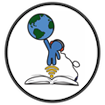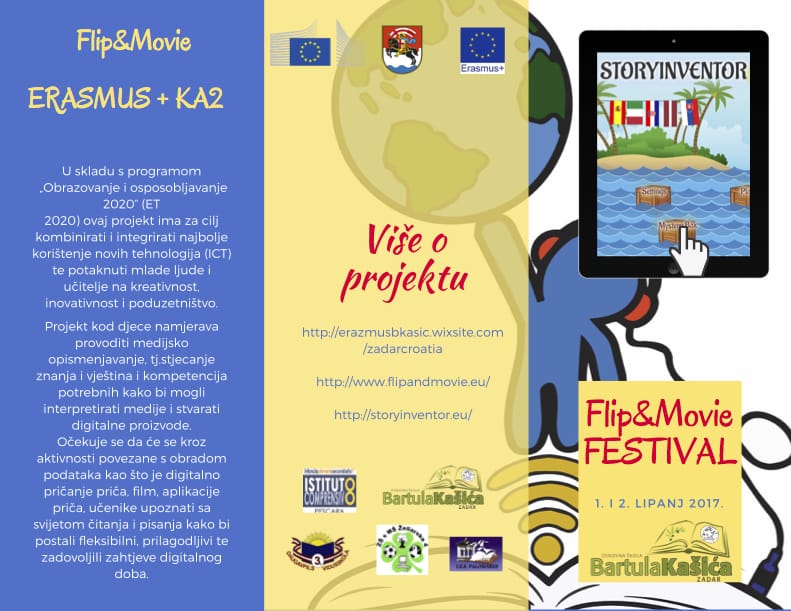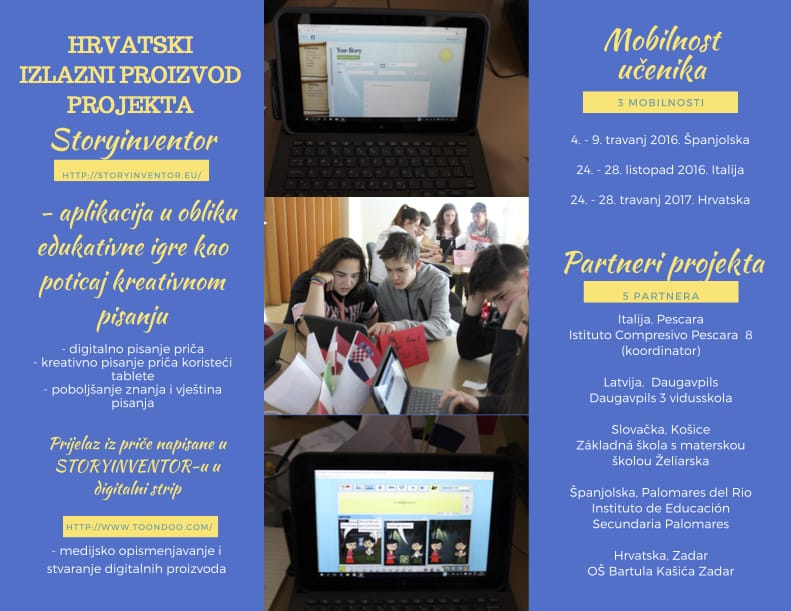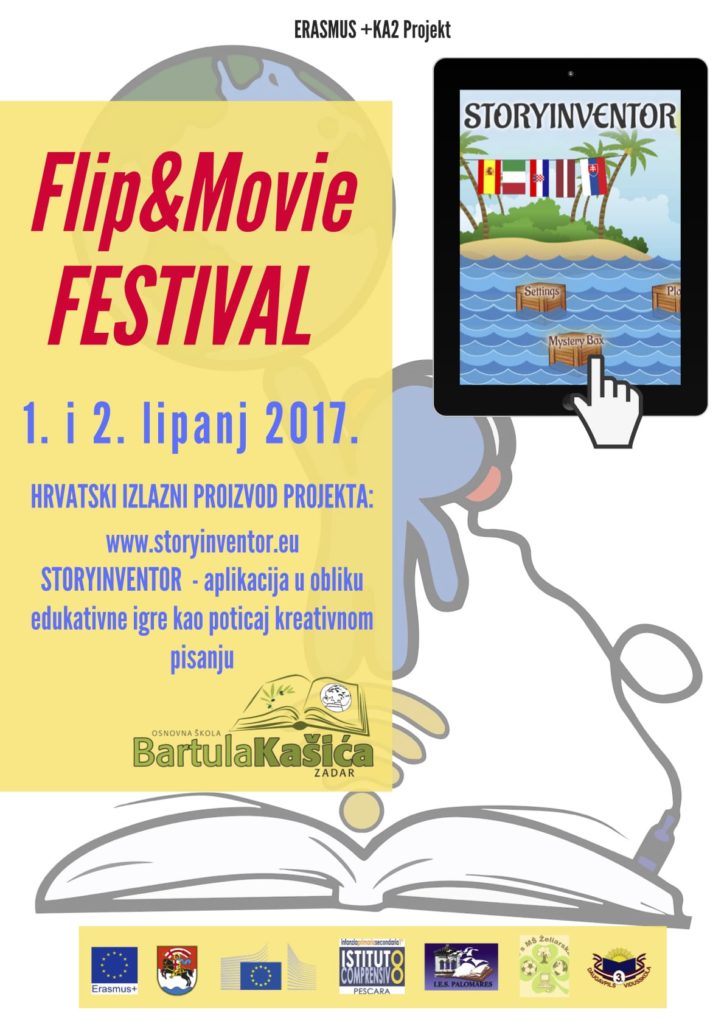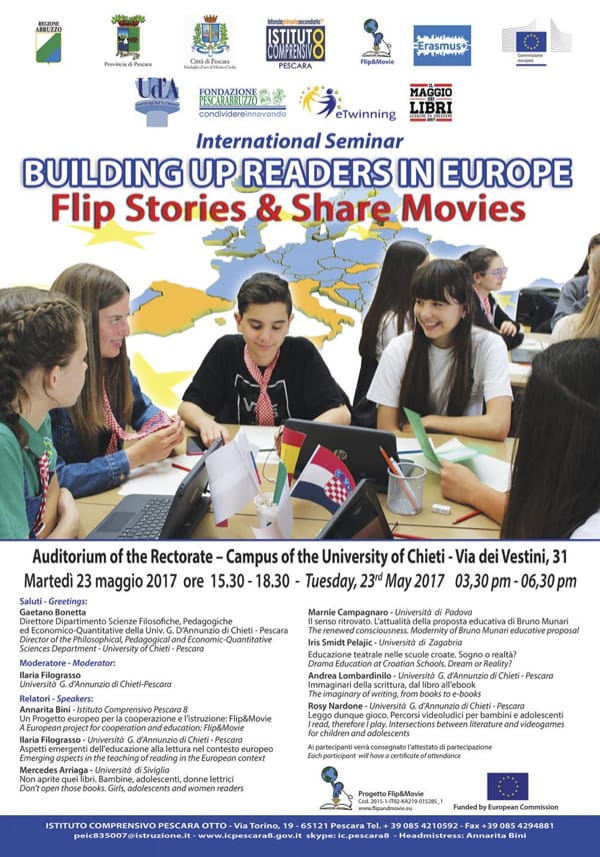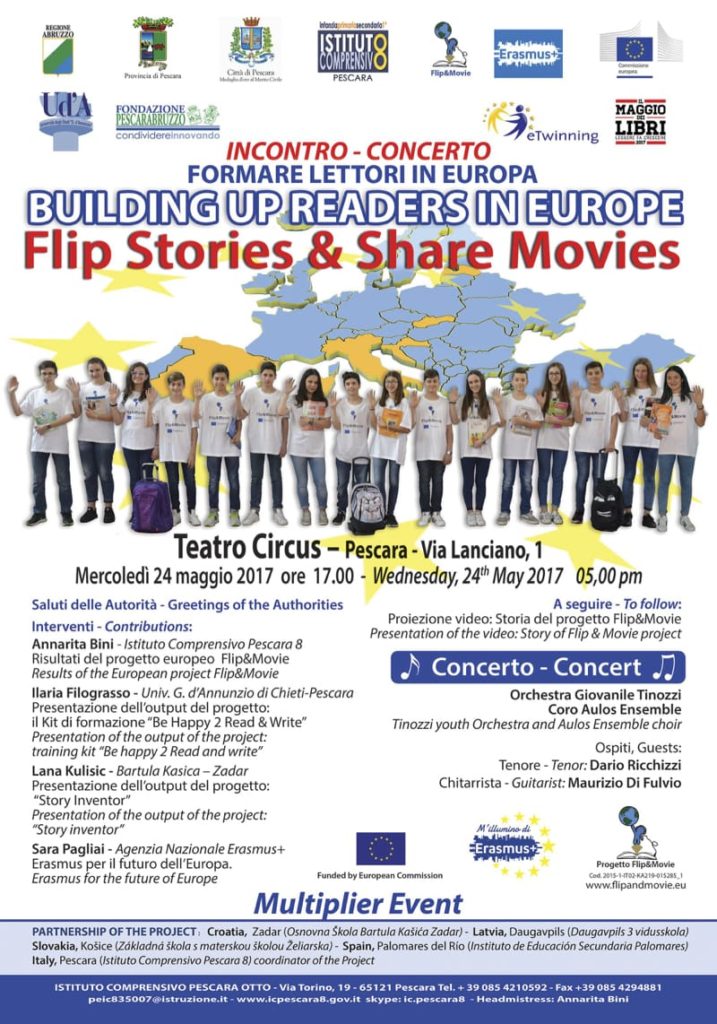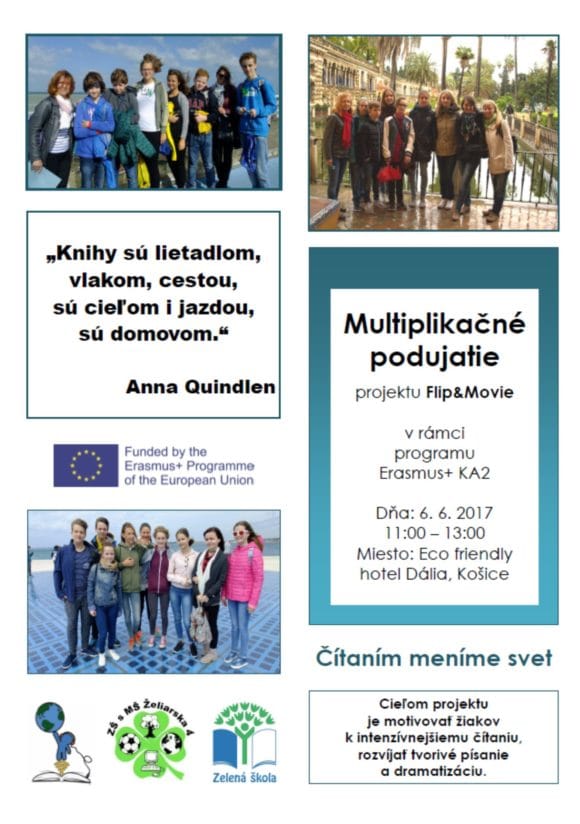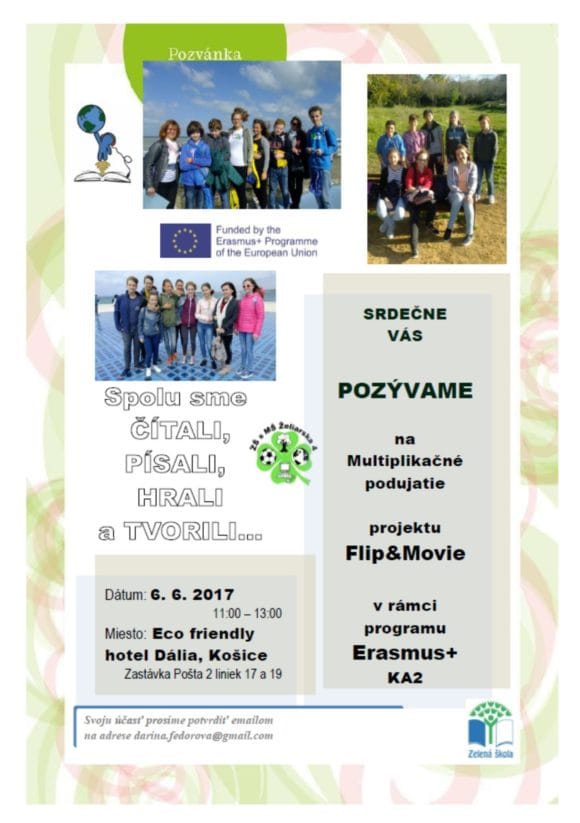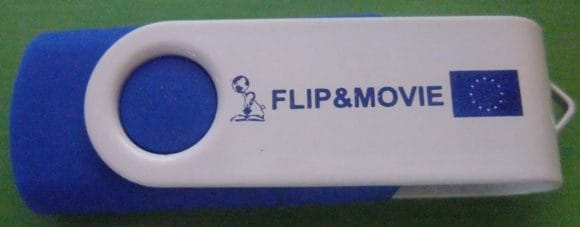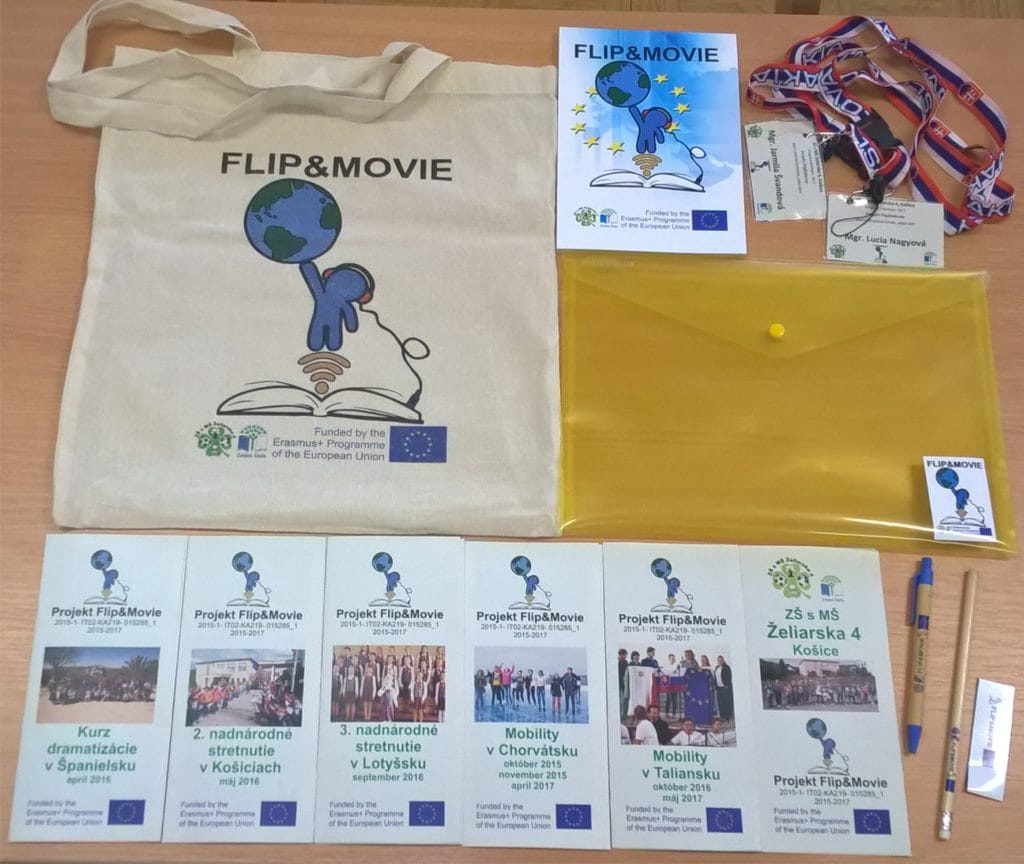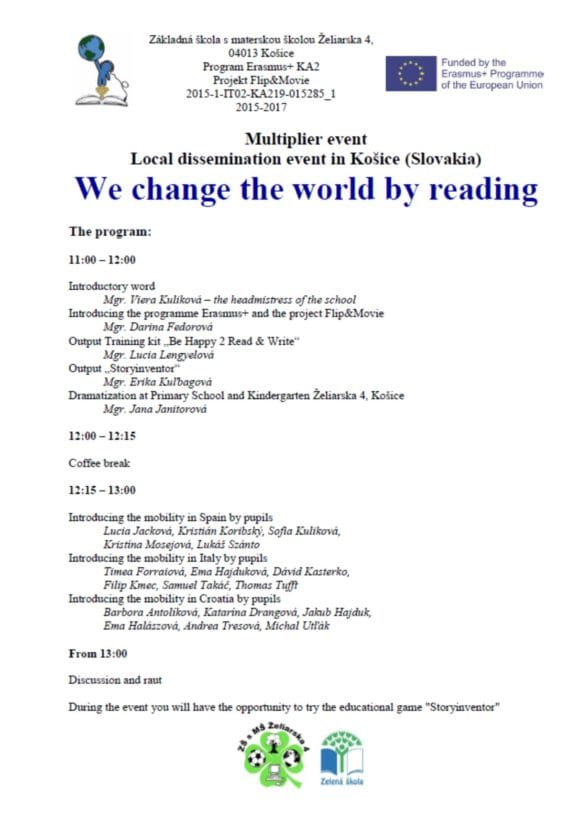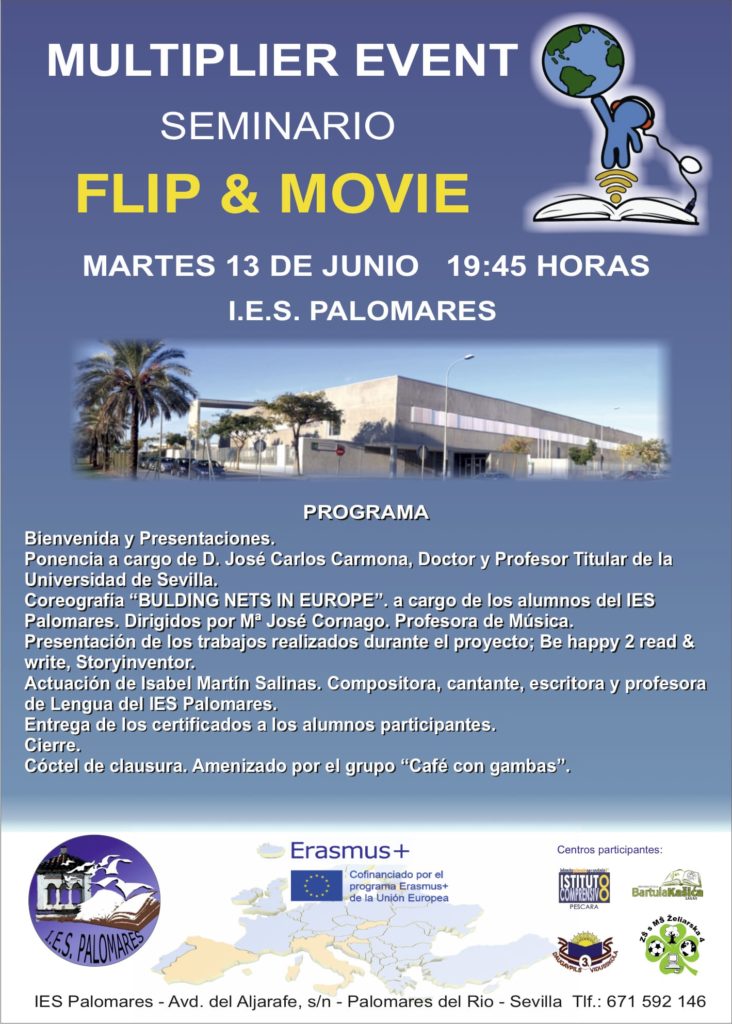CROATIA
TITLE: Flip&Movie Festival
DATE: 1st June 2017, 2nd June 2017
SHORT DESCRIPTION: Multiplier event was held in two parts.
The first part took place on the 1st June at our school. In order to present project’s activities within the two years, we invited members (teachers, professors, students) from three different organizations; Elementary school “Šime Budinić“, secondary school „Grafička škola Zadar“ and the University of Zadar. Staff members of the project participated with several presentations in order to present the project and its activities which led to the final results – outputs “BeHappy2Read&Write” and “StoryInventor”. After presentations, teachers and students participated in the workshop – digital game “StoryInventor”.
The second part of the multiplier event took place on the 2nd June in the centre of the city of Zadar. For the last eight years the City of Zadar has been organising a Day of extra-curricular activities. On that day all primary schools in Zadar have the opportunity to show what they have done during the school year. This was an opportunity for our school to present the project Flip&Movie and its results.
Setting: Public place in the City centre
Targeted population to present to: Zadar elementary schools (headmasters, teachers, pupils, parents), Local authorities (mayor, the head of Education Department of the city of Zadar etc.), citizens of Zadar, guests of Zadar…
Materials; bookmarks, leaflets, magnets, puzzles, posters, children’s stories, comics…
ITALIA
Marnie Campagnaro
FISPPA Department, Padova University.
The rediscovered sense.
The actuality of the educational proposal of Bruno Munari’s childhood books
Bruno Munari has left an important legacy to the childhood literature and to the educational practices of reading promotion, not only at an italian level but also international. His revolutionary children’s books are still a model to look at and to be inspired by. Generally, it is believed that this revolution refers to its singular visual narratives and its innovative graphic-typographic solutions. Really, Munari’s contribution is much wider. Infact the editorial Munari’s projects are special crossroads, able to interweave, around seemingly simple narrative structures, basic elements and reflections for the development of children’s cognitive, emotional, cultural and social skills. Just think, for example, of the extraordinary editorial care of his books, designed to meet the aesthetic and knowledge needs of small readers, of the renewed role of everyday life, like an imaginary place extraordinarily important for childhood, of the eucaristic and motivational function of the visual and tactile dimension of the reading process, of the many multisensorial solicitations recreated by his illustrated book that stimulate the reader to discover and investigate hidden features and meanings of the book.
My study focuses on the historical and critical-literary analysis of the contents and forms of five illustrated books (L’uomo del camion, The lorry man 1945; Mai contenti, Never satisfied 1945; Nella nebbia di Milano, In the fog of Milan 1968; I Prelibri, Pre-books 1980; Il merlo ha perso il becco, The crap has lost his beak, 1987) and aims to highlight as well as the value of the verbal and visual-aestetic narrative, the original Munari’s polimorphism in the use of the sense of tact. It will be analized the special relationship that the book can create with its own reader, starting from the tactile dimension. It is stimulated by different and unusual sensorial channels (morphological tale’s structure, combined use of different material textures, sound exploration) and is able to arouse even today, after decades, the curiosity and interest of young readers, with educational implications in many contexts: family, school, society and culture.
Andrea Lombardinilo
The imaginary landscapes of writing: from the book to the ebook
With the advent of the digital civilization, the interactional practices have been changing in compliance with the need to accelerate the exchange of experiences, knowledge and information. In this sense, the digital devices engendered a new way to make writing functional to the expressive features of postmodern society. The transition from the book to the ebook is only one of the featuring marks of the connected society, increasingly involved in the challenge to implement the degree of communicative openness. The passage from the manuscript man to the typographic, highlighted in the sixties by McLuhan, foreran the advent of the electric actors, celebrated by Benjamin and Habermas in reference to the process of reification of mass culture. Despite the frenzy development of digital devices, the ebook has not gained momentum yet.
This is what the Italian Institute of Statistics (Istat) and the Italian Publishers Association (Aie) point out in their recent Reports, respectively entitled The Reading in Italy (2016) and Report on the condition of publishing in Italy 2016.
The reports show an increase of newspaper readers against a lower demand for ebooks which in 2015 were about 5 million or 8,2% of the newspaper readers. For the first time the spread of ebooks decreased (-5,6%) among the young people (15-44 year-old people), “even though we have ebook readers above the national average” (Aie 2016). Furthermore, the Aie report points out that “readers learnt to arrange a personal mix of formats, also thanks to the increase of books and the fact that companies started to use the devices of the digital marketing in a more attentive way” (Aie 2016).
The metaphor of the patchwork effectively expresses the evolution of consumes in the digital era, marked by the appearance of new imaginary landscapes, connected to the pleasure of texts claimed by Roland Barthes (1973). Nevertheless, ebooks stand no chance against books, as confirmed by the Istat and Aie Reports. Besides those who claim to read only books (61%) or ebooks (2%), there are those (37%) who choose how to buy (in a bookshop or over the internet) and what format to use (paper or screen).
The increase of book and the decrease of ebook sales are two significant factors. Somehow they legitimate the attempt to follow the evolution of the imaginary landscapes of words highlighted by Barthes, Bourdieu and Escarpit long before the advent of the digital devices, the internet and social media. The results of the Aie and Istat Reports seem to confirm that the functionality of texts does not go hand in hand with its aestethic dimension. The pleasure of interpretation reminded by Umberto Eco in reference to the text as “producer of forgetfulness” stems from that aesthetic and imaginary dimension, enabled to capture the reader beyond the symbolic complexity of our times.
Rosy Nardone – University “G. D’Annunzio” of Chieti – Pescara
I read therefore I play.
Intersection between literature and videogames for children and adolescent.
There is a dynamic relationship among inclination to play, educational actions and new technologies.
Current video game environments fully represent a relational and communicative space of the contemporary world, putting in a fertile short-circuit the dimension of education, culture and media languages in their plurality and complexity. Video game media do not live isolated from other narrative media, but – on the contrary – there is a more and more frequent exchange of stories and contents, that recall plots or themes similar to genres existing in literature too. In fact, it is not just direct adaptation from a medium (the book) to the other (the video game), but also transversal themes shared by works from the comic world and literature. Video games, in their heterogeneous forms and developments, are a syncretic kind of storytelling, which explores different narrative and expressive forms. Images and aesthetics are two fundamental components, but it must not be forgotten that the speech remains one of the most powerful videogame engines: its digital and multimedia origin leads to the convergence of written narrative, images, sounds… in a single tool – as argued, among others, by Nicholas Negroponte and Henry Jenkins. At the same time, a video game must be able to break loose from a linear and familiar plot, with the need to create variations (as unpredictable as possible) of the original story.
I read therefore I play, but also I play therefore I read: there is a strong reciprocal inclination between a reader and a video gamer, both story users, involved in narrative dives – whether on “paper screens” or interactive screens – that offer the chance to imagine and live multiple stories from alternative points of view. Therefore, it is possible to start from a literary work, for early childhood or teenagers, and land on an App and a video game, to find its structure in it, diving, simulating and even, sometimes, twisting its original plot. Vice versa, starting from the adventures explored in the video game scenes, players can develop a passion for narrative plots on paper, digressions and magic illustrations, emotions, hallucinations, impossible endings. Or, as it happens in the videogame The Elder Scrolls V: Skyrim, players read while they play, and the experience is so engaging that many users end up getting more interested in reading the book than playing the game.
Iris Šmidt Pelajić
Drama Education at Croatian Schools. Dream or Reality?
One of the constant challenges, but also the aims and desiderata of teaching is the desire to shape the teaching in such a way that the teaching is both mediated and acquired in a playful, easily comprehensible and challenging way. Thus, when the aim of the teaching is a free development of the pupils’ personality, including the free development of their creativity, curiosity and responsibility (Šmidt Pelajić 2010: 9), the drama-pedagogical approach is one of the most efficient ways to achieve this goal. This lecture focuses on the characteristics of drama pedagogy as well as the need for a more intensive and continuous use of drama teaching techniques in school education. A survey, carried out among the students of the Faculty of Teacher Education in Zagreb, on the implementation of drama education at Croatian schools, is going to be presented. The results of the survey show how the proportion of drama education activities changes according to the level of education. While drama techniques are present and applied in the primary school, the situation is changing for students when they reach an age where their creativity is developing strongly. An age in which they are extremely creative, but at the same time insecure, too critical and too sensitive. Then they are often condemned only to memorize facts, but not to create challenging contents, express themselves creatively. Nevertheless, is it possible to overcome this negative situation and to develop students’ potentials by combining reading, writing and drama activities at any level of education? This lecture presents examples of teaching practices, which have emerged from experience, and which made it possible, to unfold students’ creativity by combining dramatization with reading and creative writing, sometimes also using the digital tools, thereby making the students authors or coauthors of texts and hypertexts published on the Internet. There are also going to be presented some practices in teacher education, that demonstrate how students can develop their creativity through childrens literature and drama techniques. By experiencing it, these future teachers realize how important it is, that afterwords, as teacher, they make it possible for the children to express their own creativity, and that they promote literacy and creativity among the children.
Zagreb, 04. May 2017
Šmidt Pelajić, Iris. 2010. „Literatur als Freiraum für interkulturelle Begegnungen“. Im Konferenzbericht: XVII. KDV-Konferenz „Interkulturelles Lernen. Konzepte. Prinzipien. Anwendungsmöglichkeiten“, / Literature as a space for intercultural encounters”. In the conference report: XVII. KDV-Conference “Intercultural Learning. Concepts. Principles. Application possibilities “, Biograd n/m, 16.–18.10.2009./ Jahrg.18, Nr. 34/35-2009, 8-19.
LATVIA
On June 7, 2017, a dissemination event of the two-year project Erasmus Plus “Flip & Movie” took place in Daugavpils Secondary School No. 3. In total, more than 60 English language teachers from Latgale region gathered in order to theoretically and practically improve their skills and abilities in teaching English.The event was opened with the introductory speech of the school headmaster Vitālijs Azarevičs and the speech of Evelīna Balode- an expert of the Education Department on project issues. The project coordinator Alina Jeremenko introduced the goals and tasks of the project. The participants of the project presented two intellectual outputs: a selection of methodical materials “Be Happy 2 Read & Write” and an engaging computer game “Storyinventor” based on national fairy tales of the partners of the project in order to develop the language and the communicative, expressive, and narrative skills in pupils and students. English language teachers and the representatives of Education department highly evaluated the project work.
SLOVAKIA
SPAIN
The Flip & Movie Seminar took place on June 13th of 2017. The event was attended by many people outside the local educational community and the Spanish team also had the collaboration of Mr. Jose Carlos Carmona Dr. of the University of Seville. During the event, the members of the Spanish staff showed the 2 intellectual outputs: the kit “Be Happy 2 Read & Write” and the educational game “StoryInventor”. “Be Happy 2 Read & Write” is a digital and paper book-reading kit. It contains 20 tutorials from partner schools. It shows innovation methodologies so that the students get a better learning in those skills. “Storyinventor.eu” is a website where the students create a story. Each partner of the project has contributed with 4 stories from each country. The characters, the plot, the places where the story goes and the endings are selected, each one of them randomly and the site provides students a guideline to create the story. In this activity students get to grow up their creativity and ingenuity to build an interesting story.
At the event they also presented the web that shows all the experiences lived throughout the project as well as the activities carried out and a video dissemination of the whole project. To conclude the event, students did a performance showing the teamwork to achieve a goal between 5 different countries: Building nets in Europe. For further dissemination they had the opportunity to participate in the multiplier event on June 7th in the CEP (Center for Teacher Training) in Seville in a conference to disseminate the Erasmus projects in the area. They prepared: folders, pens, posters, big posters, leaflets, etc. to give a publicity to the project. In the stand they offered all the information about the intellectual products. Another of the activities that took place was the presentation of the project itself. In that event they contacted the Europe Direct Seville and shared the social event poster on the social networks.
